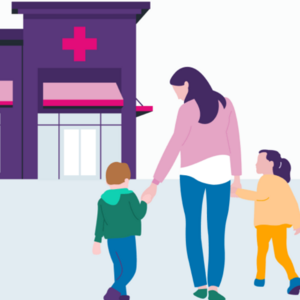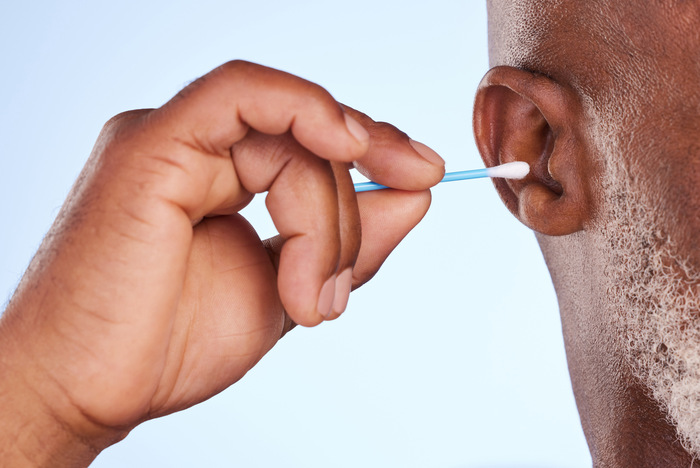
Feel better faster. Get care today.
From the clinic or your couch. Find high quality, same-day urgent care for you and your kids. Book an urgent care visit today.

Ear wax, also called cerumen, is essential to keep our ears healthy, as it can trap dust, debris and microorganisms from entering and infecting our ears. But when ear wax builds up too much, it may cause cerumen impaction resulting in painful symptoms like earache (otalgia), tinnitus (ringing in the ears), or even make it difficult to hear. Untreated ear wax impactions can cause more severe ear problems, like infections — so understanding the symptoms of ear wax build up is important.
Ear wax is a natural part of what the body does to keep the ear healthy, according to the American Academy of Otolaryngology (AAO). They explain that earwax is a yellowish, waxy substance that is secreted from glands in the external ear canal and has many protective roles. Some people get freaked out when dealing with ear wax, but it is very important for cleaning the ear canal and protecting it from foreign objects and bacteria.
According to the American Academy of Family Physicians (AAFP), ear wax is a combination of secretions of sebaceous glands, sweat glands and skin flakes that the body naturally produces to capture dust, dirt, and other foreign particles from entering the important parts of the inner ear. Moreover, ear wax also has antimicrobial functions that block the growth of the bacteria and fungi so that we can lower the risk of infection. When the jaw moves during speech or chewing food, ear wax is slowly pushed out of the ear canal — providing an efficient cleaning system for healthy ear functioning.

From the clinic or your couch. Find high quality, same-day urgent care for you and your kids. Book an urgent care visit today.
Cerumen impaction can lead to discomfort and hearing difficulties, making it important to understand the underlying causes of ear wax buildup. Ear wax, or cerumen, is produced naturally by the body to protect the ear canal, but various factors can contribute to its excessive accumulation and subsequent impaction.
Ear wax is formed by the secretion of special glands in the outer ear canal. This waxy material works to ensnare debris, dust, and microorganisms so that they cannot travel further into the ear. But some people make excess amounts of ear wax because of genetics, and others have a change in the consistency of their wax material in a way that leads to blockages, according to the AAFP. Other influences are external — such as the use of hearing aids or earplugs being used in the canal that may push some of the wax farther back in where it becomes harder for your body to expel, thus leading to impaction.
While ear wax is a natural substance that serves an important protective function, some individuals may experience blockages that require medical attention, according to the AAFP. However, they also note that not everyone with ear wax buildup needs to visit a healthcare provider. Many people can manage minor blockages at home, especially if they are not experiencing significant discomfort or hearing loss.
Some individuals who may be more likely to experience ear wax blockages according to the AAFP are:
People who use hearing aids, which can push wax deeper into the ear canal
Individuals with a lot of ear hair, which can trap wax and prevent its natural expulsion
Those who live with eczema, as skin conditions can affect ear wax production and consistency
People who frequently use cotton swabs, which can inadvertently push wax further into the ear
Individuals with misshapen or narrow ear canals, making it difficult for wax to exit naturally
Older adults, whose ear wax may become drier and harder over time
Children, who may be more prone to ear infections and wax buildup due to their developing ear anatomy
When cerumen accumulates excessively, it can lead to a variety of uncomfortable and disruptive sensations. Recognizing the symptoms of a clogged ear due to ear wax blockage is important for getting timely intervention and treatment to relieve symptoms.
Some common symptoms associated with an ear wax blockage, according to the Audiology.org:
Earache or discomfort in the affected ear
Hearing loss or reduced auditory clarity
Dizziness or a feeling of imbalance
Tinnitus, or ringing in the ear
Itchy sensations within the ear canal
Discharge from the ear, which may indicate irritation
Ear infections, which can occur due to trapped moisture and bacteria
A feeling of fullness or pressure in the ear
Coughing, which can sometimes be a reflex response to ear pressure changes
When dealing with impacted ear wax, safety is a primary concern for many individuals seeking relief from discomfort and hearing issues. The safest and most reliable way to remove impacted ear wax is by having it done by a qualified health professional, such as an ear, nose, and throat (ENT) specialist or a primary care physician. These healthcare professionals are trained to assess the extent of the blockage and utilize appropriate techniques — such as irrigation, suction, or manual removal, to ensure that the ear canal is cleared without causing damage to the delicate structures of the ear.
Attempting to remove ear wax at home using tools like cotton swabs or other implements can often push the wax deeper or lead to injury, infection, or other complications, according to the AAFP. Therefore, consulting a professional is the best approach for safe and effective ear wax removal.
Healthcare providers employ various safe and effective methods to remove ear wax. This ensures that the process is conducted with precision and care. During a typical ear wax removal procedure, the healthcare provider will first conduct a physical examination of the ear using an otoscope, which allows them to visualize the ear canal and assess the extent of the blockage. Depending on the situation, they may employ different techniques for removal.
Common methods include irrigation, where warm water or saline is gently flushed into the ear canal to dislodge the wax, or manual removal using specialized instruments like a curette or suction device, according to the AAFP. These methods are performed with care to minimize discomfort and prevent injury to the ear, ensuring that patients receive safe and effective treatment for their ear wax impaction.
While some individuals may experience minor blockages that can be managed at home, there are specific signs and symptoms that indicate it is time to consult a healthcare professional.
The AAFP explains that if you are experiencing significant discomfort, persistent hearing loss, or any unusual symptoms, it is advisable to seek help from an ear wax removal doctor. Additionally, individuals who use hearing aids, have a history of ear infections, or possess anatomical variations in their ear canal should also consider regular check-ups to prevent wax buildup.
Use Solv to find an ear wax removal provider today and book a same-day or next-day appointment directly from the website.
Ear wax, also known as cerumen, is a yellowish, waxy substance secreted from glands in the external ear canal. It serves several protective roles, including trapping dust, debris, and microorganisms to prevent them from entering and infecting the ear. Ear wax also has antimicrobial functions that block the growth of bacteria and fungi, reducing the risk of infection.
Cerumen impaction can occur due to various factors. Some people may produce excess amounts of ear wax due to genetics or changes in the consistency of their wax material, leading to blockages. External factors such as the use of hearing aids or earplugs can push wax farther back into the ear canal, making it harder for the body to expel and leading to impaction.
Individuals who use hearing aids, have a lot of ear hair, live with eczema, frequently use cotton swabs, have misshapen or narrow ear canals, are older adults, or are children may be more prone to ear wax blockages.
Symptoms of an ear wax blockage may include earache or discomfort in the affected ear, hearing loss or reduced auditory clarity, dizziness, tinnitus (ringing in the ear), itchy sensations within the ear canal, discharge from the ear, ear infections, a feeling of fullness or pressure in the ear, and coughing.
No, it is not recommended to remove impacted ear wax at home using tools like cotton swabs or other implements, as this can often push the wax deeper or lead to injury, infection, or other complications. The safest and most reliable way to remove impacted ear wax is by having it done by a qualified health professional, such as an ear, nose, and throat (ENT) specialist or a primary care physician.